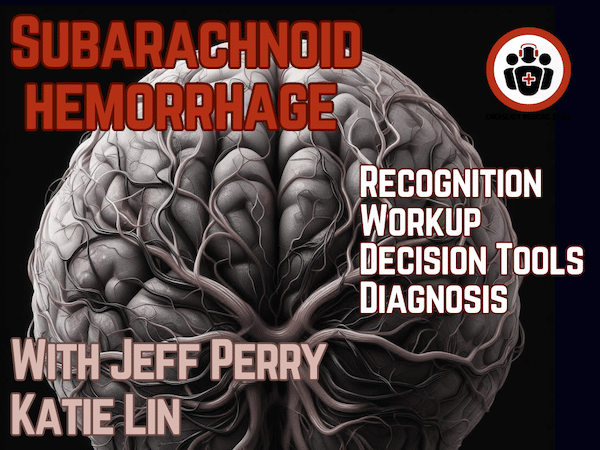Revision Resources
Recent Posts View All
May 24 FOAMed
Subarachnoid Haemorrhage

Spontaneous subarachnoid hemorrhage is bad: Fifty percent mortality rate with half the survivors suffering from significant chronic disability. A whole one quarter of patients die in the field. Of those who make it to the ED, a few will be crashing in our resuscitation rooms, but most will just have a headache. So, the problem we face in the ED with SAH is two-fold: First, the clinical manifestations range from just a headache alone – maybe a sentinel leak, to comatose and death. The second problem is that once we identify a subarachnoid bleed, secondary bleeding and ischemia snowball fast leading to delayed badness. It follows that our job in the ED is two-fold: We need to find the needle in the haystack of headache-alone patients who have a SAH.
Paediatric Fever

Fever is one of the most common acute presenting complaints in Paediatrics, with 20-40% of parents reporting at least one episode per year.
Assessment and diagnosis can be difficult when covering a broad spectrum, from self-resolving mild upper respiratory tract infections to severe bacterial infections leading to sepsis. Research around this area often focuses on differentiating bacteria from viral infections, ensuring appropriate antibiotic prescribing, and separating those who can recover at home with paracetamol from those who require admission for more intensive observation and management.
However, the list of differentials for fever in a child goes far beyond the initial ‘bacterial vs viral’ debate in those whose fever does not disappear after a few days of antibiotics or supportive care.
Lung Ultrasound for Pneumothorax

A 74-year-old male with a history of COPD arrived in the emergency department in respiratory distress. On physical examination, the patient was mildly tachypneic and had an oxygen saturation of 93% on a non-rebreather mask. On auscultation, the patient had wheezing and diminished air movement bilaterally. A supine chest radiograph (CXR) was obtained. A short time later, a radiologist called to confirm the presence of a “moderate sized right pneumothorax”. As a chest tube tray was being prepared, a bedside ultrasound (US) was performed and showed bilateral lung sliding. Is lung US more or less sensitive and specific than CXR in diagnosing pneumothorax?
Brainstem Strokes

A 74-year-old female with a past medical history of hypertension, diabetes, recent basilar artery stent placement with a 20 pack-year smoking history presents to the ED via EMS for altered mental status and episodes of apnea.
Vital signs include BP 168/89, HR 96, T 98.3, RR 3, SpO2 95% on 15L non-rebreather mask. Symptoms started acutely about 15 minutes prior to arrival. On exam, the patient opens eyes to voice, has extraocular movements intact, is unable to speak, and has 0/5 strength in all extremities. The patient was intubated for acute hypercapnic and hypoxic respiratory failure and airway protection.
CT head without contrast is performed and reveals the following…
Are you sure you wish to end this session?

